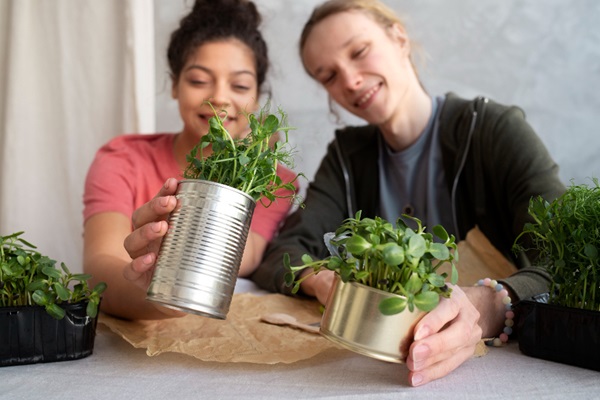Companion planting is an age-old strategy that involves growing different plant species close together to create a more balanced, productive, and pest-resistant garden. By understanding how certain crops can benefit one another—whether it’s through improved nutrient availability, enhanced pest control, or better pollination—you can harness the power of companion planting to cultivate a thriving and sustainable growing environment. The concept goes beyond simply placing plants side by side; it embraces the idea of creating miniature ecosystems where every organism, from beneficial insects to nitrogen-fixing bacteria, plays a crucial role in boosting overall garden health.
Understanding the Principles of Companion Planting for a Healthier Garden
A key aspect of companion planting is focusing on synergy rather than isolation. Instead of treating each vegetable, herb, or flower as a standalone unit, consider their interactions with neighbors. Certain plants release substances that repel pests or improve soil quality, while others attract pollinators or beneficial insects. Some even offer physical support or shade to their companions. By thoughtfully selecting and pairing crops, it becomes easier to maintain balance, reduce reliance on chemical inputs, and encourage long-term soil fertility.
Core Benefits of Companion Planting
- Enhanced Pest Control: Many companion plants act as natural insect repellents. Their odors, colors, or chemical compounds deter pests or distract them away from your main crops.
- Nutrient Management: Some species, like legumes, fix nitrogen in the soil, making it more readily available to their neighbors.
- Improved Pollination: Flowering companion plants attract pollinators, ensuring better fruit set and higher yields.
- Weed Suppression: Ground-covering companions help block sunlight and prevent weeds from taking over.
- Moisture Retention and Shade: Taller or leafier plants can protect smaller, shade-loving crops from harsh sunlight.
For more insights on optimizing your growing environment, consider reading our article on The Science of Soil: Understanding and Improving Soil Composition for Better Yields.
Choosing the Right Plant Combinations to Maximize Growth and Yield
Successful companion planting hinges on selecting the right partners. Consider each plant’s growth habits, nutritional needs, and susceptibility to pests. Look for pairings that address known weaknesses. For example, if a particular crop is prone to aphid infestations, a nearby plant that repels aphids can help maintain balance.
Popular Companion Plant Pairings
- Tomatoes and Basil: Basil’s strong aroma can deter pests like whiteflies and improve the flavor of ripe tomatoes.
- Carrots and Onions: Onions release compounds that mask the scent of carrots, making it harder for carrot flies to locate their target.
- Corn, Beans, and Squash (The Three Sisters): Corn provides a support structure for climbing beans, beans fix nitrogen for the trio, and squash leaves shade the soil, reducing weed growth.
To explore eco-friendly pest management techniques that complement companion planting, visit Eco-Friendly Pest Control: Natural Solutions for Healthy Vegetable Gardens.
Designing Your Garden Layout for Optimal Companion Planting Success
Proper garden design is essential when implementing companion planting. Consider each plant’s size, shape, and sun exposure requirements. By arranging crops strategically, it’s possible to ensure each plant receives enough light, nutrients, and space to thrive.
Tips for Effective Garden Planning
- Layer Crops by Height: Place taller plants toward the back or north side of the garden to prevent shading shorter companions.
- Group Plants by Growth Rate: Fast-growing crops can provide temporary shade and protection for slow growers, while maturing at complementary times.
- Use Row Covers and Trellises: Structures can separate plants that aren’t compatible, while also maximizing vertical space for climbing crops.
- Leave Adequate Spacing: Even beneficial companions need room to develop properly. Overcrowding reduces airflow, increasing the risk of disease.
If you need guidance on getting the most out of limited space, consider our post on Innovative Container Gardening: Growing Vegetables in Small Spaces.
Enhancing Biodiversity: Attracting Beneficial Insects and Pollinators
Biodiversity lies at the heart of companion planting. The more diverse your garden, the less vulnerable it becomes to pests and diseases. Introducing flowering plants, herbs, and shrubs that attract beneficial insects fosters a dynamic ecosystem where predators and pollinators keep harmful pests in check.
Strategies for Attracting Helpful Organisms
- Native Flowers and Herbs: Native species are adapted to local conditions, offering reliable pollen and nectar sources that attract pollinators and predators.
- Continuous Bloom Cycles: Plant a variety of species that bloom at different times to ensure a steady food supply for beneficial insects.
- Provide Shelter and Water: A shallow water dish and a few undisturbed areas of the garden can create inviting habitats for ladybugs, lacewings, and predatory wasps.
Using Companion Planting to Minimize Chemical Inputs
One of the significant advantages of companion planting is the reduced need for synthetic pesticides and fertilizers. By relying on nature’s balance, you can create a more sustainable gardening practice that protects both the environment and your harvest.
Key Practices for Reducing Chemicals
- Natural Pest Repellents: Aromatic herbs, like rosemary or mint, repel insects, lessening the need for chemical sprays.
- Nutrient-Fixing Plants: Legumes such as peas and beans boost soil nitrogen levels, decreasing reliance on synthetic fertilizers.
- Green Manures and Cover Crops: Planting legumes or clover between main crops improves soil health and reduces fertilizer usage over time.
For information on creating nutrient-rich soil amendments, refer to our guide on DIY Homemade Fertilizer: Turning Kitchen Scraps into Nutrient-Rich Soil.
Combining Crop Rotation and Companion Planting for Long-Term Soil Health
Crop rotation and companion planting work hand in hand. Rotating crops each season prevents the buildup of soil-borne pests and diseases. When paired with carefully chosen companions, this approach leads to healthier soil, more resilient plants, and improved yields over the long run.
Steps for Integrating Rotation and Companions
- Rotate Crop Families: Avoid planting the same type of crop (e.g., all nightshades) in the same spot year after year.
- Follow Heavy Feeders with Soil-Builders: After growing nutrient-demanding vegetables, plant legumes or cover crops to replenish the soil.
- Track Your Combinations: Keep a gardening journal to note which pairings performed well and which rotations minimized pest pressures.
For more details on this approach, review The Essential Guide to Crop Rotation: Boosting Soil Health and Yield.
Using Companion Planting to Improve Soil Structure and Reduce Erosion
Beyond pest control and nutrient management, companion planting contributes to better soil structure. Plants with varying root systems break up compacted soil, enhance drainage, and prevent erosion by stabilizing the ground with their roots.
Techniques to Improve Soil Structure
- Mix Deep and Shallow-Rooted Crops: Combine taprooted vegetables (like carrots) with those that have fibrous root systems (like lettuce) to promote soil aeration and nutrient circulation.
- Ground Covers for Erosion Control: Low-growing plants, such as creeping thyme or clover, help protect soil from heavy rain and wind.
- Regular Organic Matter Additions: Top dress with compost or leaf mold to foster a habitat for earthworms and microorganisms that further improve soil texture.
Avoiding Common Companion Planting Mistakes
Like any gardening technique, companion planting requires trial, error, and adaptation. Mistakes happen, but understanding common pitfalls can help you achieve better results faster.
Common Errors and Solutions
- Overcrowding Plants: Too many companions in a small space limit airflow, increasing disease risk. Follow recommended spacing guidelines.
- Incompatible Pairings: Certain plants, such as fennel, may inhibit the growth of nearby crops. Research companion relationships before planting.
- Ignoring Soil pH and Sunlight Needs: Even ideal plant partners won’t thrive if the environmental conditions do not match their requirements.
Adapting Companion Planting to Your Climate and Growing Conditions
Local climate, soil type, and growing season length all influence which companion planting strategies work best. Gardeners in cooler climates might prioritize season-extending techniques, while those in warmer regions focus on water conservation and heat-tolerant crops.
Tailoring Strategies for Your Environment
- Choose Drought-Resistant Partners: In arid climates, select plants that share similar water needs and help maintain soil moisture.
- Optimize Warm-Season Pairings: In hot regions, tall, leafy companions provide welcome shade to more delicate crops.
- Extend the Season: Cold frames and row covers let you experiment with companions during cooler months.
Experimenting and Refining Your Companion Planting Skills
Every garden is unique, and it may take several seasons to discover the companion plant combinations that yield the best results. Continuous observation, experimentation, and flexibility are key to fine-tuning your approach.
Strategies for Growth and Improvement
- Keep Records: Document which pairings worked well, along with weather patterns and any pest outbreaks.
- Seek Reliable Sources: Books, extension services, and reputable gardening websites provide ongoing guidance. The U.S. Department of Agriculture (USDA) offers valuable resources for understanding plant relationships.
- Learn from Others: Connect with local gardening clubs or online communities to share experiences and learn from fellow enthusiasts.
Incorporating Flowers, Herbs, and Ornamentals for Aesthetic and Functional Benefits
Companion planting isn’t limited to vegetables. Integrating ornamental flowers and culinary herbs adds beauty, fragrance, and flavor to your garden while also providing functional benefits like attracting pollinators and deterring pests.
Ideas for Multi-Purpose Plantings
- Marigolds and Nasturtiums: These vibrant flowers repel common garden pests and brighten up vegetable beds.
- Chives, Thyme, and Sage: These herbs add culinary value, help mask crop scents from pests, and attract beneficial insects.
- Roses and Alliums: Planting alliums near roses can deter aphids and elevate garden aesthetics.
Embracing a Holistic Approach to Gardening
Companion planting exemplifies a holistic, nature-inspired perspective on gardening. Rather than viewing each element in isolation, this method encourages seeing the garden as an interconnected web of relationships, where every choice influences the ecosystem’s overall health.
Long-Term Advantages of a Holistic Mindset
- Reduced Dependence on Chemicals: Stronger plant communities lower the need for synthetic pesticides and fertilizers.
- Stable Ecosystems: Diverse and well-managed gardens adapt more easily to environmental changes, pests, and diseases.
- Greater Satisfaction: Cultivating a garden that works in harmony with nature fosters a deeper appreciation for the complexity and resilience of the natural world.
By unveiling the power of companion planting, gardeners can achieve healthier crops, higher yields, and a more sustainable environment. This approach leverages the strengths of various plant species, enhances soil fertility, and promotes beneficial insect activity—all while reducing the need for chemical inputs. Over time, a garden designed around symbiotic relationships becomes more resilient, productive, and visually appealing. Embrace companion planting to take your gardening experience to the next level, crafting a space where every plant, insect, and microbe contributes to a thriving, balanced ecosystem.
Learn more about this topic with The Year-Round Vegetable Garden for Beginners.


Leave a Reply